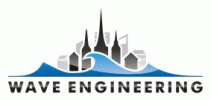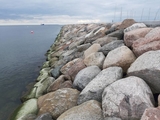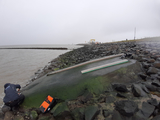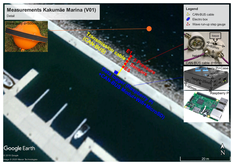Field measurements of wave run-up on coastal structures with a pressure step gauge
Description
Wave run-up field measurements on German sea dikes have been carried out at the German North Sea coast in the last decade by the local authority responsible for coastal protection of the federal state of Schleswig-Holstein (LKN-SH) and in cooperation with the Institute of River and Coastal Engineering of TUHH (cp. Fig. 2). Lately, TUHH has developed a new prototype for wave run-up field measurements. Among others, the results have been used to validate and improve empirical formulas proposed in the well-known EurOtop manual.
We would like to use German know-how and equipment to measure wave run-up on local rubble mound breakwaters (cp. Fig. 1) which are adapted to icy conditions (with a smooth slope, similar to German sea dikes) and are thus different from normal breakwaters. The results are expected to have influence on empirical wave run-up calculations in Nordic and Baltic countries and thus improving cost-effective coastal engineering and management.
Moreover, the wave conditions near the breakwater are monitored with the help of a prototype for a miniature wave buoy (d=50cm, cp. Fig. 3) which will be validated and improved within an international research cooperation between scientists and engineers from Taiwan, Estonia and Germany.
The aims of the project are: i) implementation and optimization of the step gauge, ii) validation and improvement wave run-up formulas (e.g. EurOtop), iii) joint analysis and assessment of measurements at the North Sea and Baltic Sea, and finally iv) dissemination of results (public seminars and preparation of a joint scientific publication).
Background
The project participants know each other from scientific exchanges (e.g. a guest stay of Mr. Rain Männikus at TUHH in 2019) and the interests are based on joint research on the hydrodynamic conditions in the Baltic Sea and the consequences for coastal protection structures. A joint publication of the participants of the project (authors: Mr. Norman Dreier, Mr. Rain Männikus, Mr. Peter Fröhle) was submitted to the International Coastal Symposium 2020. One of the aims of the project is the deepening of the relations between project partners and to exchange knowledge on the scientific questions for the preparation of future joint-project applications of the partners.
Timeline of the project
The project was initially meant to be carried out from January to October 2020. The public seminars were intended to be organized in Tallinn and Riga to present the results. Due to the spread of COVID-19, the research project was deeply impacted and had to be reorganized. Preparation of measurement devices and their implementation were delayed. The physical meetings and stays in Estonia were cancelled. However, the delay did not affect the quality of measurements and analysis, because the meetings were successfully carried out online and the supporter of the project, the Baltic-German Universities Liaison Office provided flexible support. The following timeline deviates from the proposed one and reflects the activities done.
|
Concrete project activity |
Detailed description of the activity |
Duration of the activity |
|
|
Date |
|||
|
from |
to |
||
|
1. Kick-off meeting (video) |
Presentation of the project and discussion of work program |
Feb |
Feb |
|
2. Preparation |
Selection of a possible study site and acquisition of measurement equipment |
Feb |
July |
|
3. Implementation |
Set-up of the system at the study site |
July |
August |
|
4. Measurements and maintenance of the system |
Conduction of field measurements of waves and wave run-up and maintenance of the system |
August |
December |
|
5. Analysis of results |
Joint-analysis of measurements at the German and Estonian Coast |
October |
… |
Presentations about the results
- Description of measurements in Haven Kakumäe, 2020 (Rain Männikus)
- Field measurements of wave run-up on coastel structures with a pressure step gauge (Norman Dreier)
Short conclusions and further work
The measurement devices in Haven Kakumäe were set up in August 2020. Due to Covid-19 restrictions, the travelling of German scientists and specialists from Hamburg was not possible. Therefore, an Estonian electrician company was asked to set up the pressure sensors on the slope of the breakwater and the data logger and devices in Haven Kakumäe. At the same time, a directional wave buoy which was ordered from Institute of Hydrological and Oceanic Sciences at the National Central University in Taiwan, was set up approximately 100 m seaward of the breakwater (see Figure 3). As of December 2020 the measurements are ongoing and are planned to continue at least throughout the winter 2021 and longer if possible. The successful implementation of the wave run-up step gauge based on pressure sensors and wave measurements at the Estonian coast provide a unique basis for further joint analysis of wave run-up events both at the German North Sea coast and the Estonian Baltic sea coast. First wave run-up events have been analysed during a storm on 17th September 2020 with maximum run-up heights up to 1.8m. The field measurements of wave run-up and waves will be continued and the step gauge will be optimized for the detection and analysis of the wave run-up events. The results of the analysis will be used for the comparison between the measured average wave run-up heights (Ru2%) and the hindcast of average wave run-up heights calculated with the empirical EurOtop (2016) approach. Moreover the results are being used for the improvement of the wave run-up forecast as a basis for coastal hazard early warning systems that take into account different loads on and the resistance of coastal structures.
Acknowledgements
This project of the Baltic-German University Liaison Office is supported by the German Academic Exchange Service (DAAD) with funds from the Foreign Office of the Federal Republic Germany.
Dieses Projekt des Baltisch-Deutschen Hochschulkontors wird durch den Deutschen Akademischen Austauschdienst (DAAD) aus Mitteln des Auswärtigen Amtes der Bundesrepublik Deutschland gefördert.
Projekti toetab Saksamaa Liitvabariigi Välisministeeriumi vahenditest Saksa Akadeemilise Vahetusteenistuse (DAAD) kaudu Balti-Saksa Kõrgkoolide Büroo.




